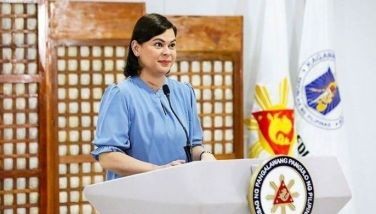The tropical plant paradise of Hawai’i

Part III
HONOLULU, Hawaii – The refreshing circle of verdant green mountains furrowed by volcanic lava flow greets the visitors as they alight from their flight to Honolulu. Along the spacious smooth roads leading to the hotel plumeria trees (kalachuchi) with white, pink or red blossoms and widespread acacia trees covered with bouquets of peach or pink flowers. Less pricey hotels and shopping malls are in Ala Moana, not Waikiki.
The top 10 sights of O’ahu island
O’ahu island is the most crowded of Hawaii’s four major islands. Tourists and retirees frequent it. The top 10 sights of Honolulu can be reached by public transportation. It took me 3 kilometers to walk to the major bus station fronting the mile-long Ala Moana beach from the Pagoda hotel. It felt good to hear the bus GPS activated-narration stating “Aloha, welcome to Honolulu”” every time I board the bus. The most popular one stop historical tour is clearly identified for instance, “Kamehameha Statue, the Capitol State Building, Iolani Palace, the Kapiolani Medical Center and the Mission House.” It commemorates the original site of the ancient royal Hawaiian kingdom of King Kamehameha I.
The island is blessed with 130 golden sand beaches that slopes gently into the blue expanse of the ocean. The two mile strand of a dozen beaches in Waikiki is just outside the hotel doorstep. The Hanauma Bay Nature reserve in East Honolulu is premiere snorkeling and sunbathing destination. Kailua Bay is a favorite kayaking, windsurfing and sailing location with small shore breaks for beginning body surfers, windsurfing and stand-up paddling lessons on a relatively uncrowded beach.
Guided land tours are a tradition on O’ahu. Affordable tours can take you to the Polynesian Cultural Center where good-looking students of Brigham Mormon College demonstrate cuisine, crafts, dances of about 8 Polynesian islands. Regular bus can bring you to the USS Missouri and Pearl Harbor sites where you can tour “Mighty Mo,” the huge aircraft carrier, where the peace agreement of World War II with Japan was signed. Tours are also available to see the film setting of Hawaii 5-O, the Pirates of the Caribbean: on Stranger Tides episode, Blue Crush filmed at North shore. Hunger Games and Godzilla.
One can take a bus to Diamond Head, where the estate of the late tobacco heiress and philanthropist Doris Duke devoted many years of her life to collecting Islamic art at Shangri La. Duke willed a large share of her estate to the study of Middle Eastern art and culture. Her 5-acre residence was opened for tours.
Representing 30 bromeliads societies of the world
The 21st World Bromeliad Conference was hosted by Jay Thurrott and Lynette Wagemen of the Hawai’i Bromeliad Society, last September 9 to 14, 2014 at Ala Moana Hotel, Honolulu. Participants from Australia, New Zealand, Philippines, Thailand, Taiwan, Belgium, United Kingdom and major plant growers of Houston, Texas and Florida were present in the conference.
Experts like Geoff Lawn discussed the BSI Cultivar Registrar, which includes the history of naming cultivated plants and creation of international naming codes. That allows the breeder to rightfully claim his hybrid creation and provide reference for other new breeders. Nigel Thompson excited everyone by introducing the topic “Feed or not to Feed” with the powerpoint of the cowboy film “The Good, the Bad and the Ugly” with Lee Van Cleef to help distinguish the truly beautiful bromeliads from the ugly. Then he identified the fertilizers for roots or foliage.
Andy Siekkinen, BSI director for Western US Region, and a nanotechnology chemist, gave us a close-up of sourcing botanical Bromeliad diversity in low coastal Tropical Dry Forests, mountains, canyons, deserts, and even high elevation cloud forests of Oaxaca, Mexico where he with his Eagle Eye Adventure (www.eagle-eye-adventure.com) tours take small groups of bromeliad hunters.
Pamela Koide-Hyatt, Andy Siekkinen’s colleague, is owner of Bird Rock Tropicals, a Bromeliad nursery in Encitas, California that specializes in the genus Tillandsia. Her lecture about Tillandsia Hydrizization: natural, artificial and accidental included a visual powerpoint of her enormous and systematically arranged nursery a huge production she put together since 1981. Having mastered the “how to” methods of pollinations, labeling, record keeping and germination, she discovered new species of hybrids. Her Tillandsia Samantha won 2013 Floral Holland Glass Tulip Award and 2012 Semi-Finalist ‘Plant of the Year’ RHS Chelsea Flower Show in London.
What are bromeliads?
Bromeliads are colorful hybrids of the crown of pineapple plant. Through hybridization and pollination in the past, they have become ornamental plants. As monocot flowering plant, it has developed into 3,170 species in approximately 56 genera and classified as plant family – Bromiliacae.
They are found in tropical Americas and American subtropics like Equador, Brazil, Mexico and tropical West Africa. The best known bromeliads are guzmania, aechmea, vriesea, neoregelia, cryptanthus and tillandsias. Bromeliads entered recorded history some 500 years ago, when Columbus introduced the pineapple (Ananas comosus) to Spain upon return from his second voyage to the New World in 1493. On that voyage, he found it being cultivated by Carib Indians in the West Indies.
Within the last hundred years, bromeliads have become more widely used as ornamental plants. Originally only found in royal botanical gardens or the private greenhouses of wealthy Europeans, their popularity has spread to the masses. Today, bromeliads are more available to the enthusiasts than ever before. New species are still being discovered and plant breeders are developing even more stunning hybrids to choose from.
Plants and crafts sale
The Plants and Crafts Sale held in the Hibiscus Ballroom displayed five long tables of vrieseas from nurseries of Sharon Peterson, neoregelias and achmea from David Fell, tillandsia galore from California nursery of Pamela Koide-Hyatt and 8 other growers.
Just as it’s not easy to bring plants into Hawai’i, there are also some restrictions on mailing, shipping, or carrying plants out of the state. Basically, plants in soil cannot leave the state, which is why one Bromeliad that easily gets a pass is the air plant Tillandsia usnoides, known locally as hinahina. After inspection, however, most bromeliad plants and cuttings can be mailed, shipped, or carried out of state. Our group bought varieties of bromeliads and a collection of seeds from flowering trees for our Botanic Park in Alfonso Cavite.
The banquet and the rare plant auctions
The conference was capped by a banquet. Before dinner, the Houston bromeliad growers invited us to an open bar and Hors d’oeuvres reception to publicize the 2016 Bromeliad Society Conference in Houston, Texas. A “silent auction” was also held to raise funds for the society’s future projects. Donations ranged from antique royal quilt, a gold necklace, old map of Hawaii, excellent picture books on bromeliads of Ecuador, Brazil or sets of important collection of Botany books were attractively laid out on the side table of the ballroom. A paper is placed for participants could write the amount of their bid. I was the last one to bid for the best pictorial book on bromeliads all over the world. The highest bidder put down $200 so I tried to bid $220. No one contested it.
Simultaneously, an auction was ongoing for rare collection of bromeliads and tillandias. Plants such as Neoregelia “Cat’s Pajama”, Neoregelia “Sugar Buzz” and Neoregalia “Hawaiian Beauty” were auctioned. There are even plants that will be named after whoever wins in the bidding. The bidding starts at $50 and even reached $650. Dr. Fernando Silvestre Jr. and Mr. Boyet Ganigan won the bid for Vriseria Catmandoo, a sibling of the Vriseria Cat’s Pajama which is one of the only four catmadoos in existence in the whole of Hawai’i.
Neotropica in Hawai’i
Hawai’i possesses 10 of world’s 15 types of climate zones. Each of the Hawaiian Islands is fantastically different. Beneath the islands lie a powerful tectonic plate, which is constantly in motion, still churning molten lava. ‘Big Island’ of Hawai’i is directly above the hot spot, the youngest of the Hawaiian chain. The other islands to the northwest – Maui, Lanai, Molokai, Oahu and Kauai are older and farther away from the hot spot. ‘Big Island’ is made of 5 volcanoes, each born successively. Kohala is the oldest, followed by Hualalai, Mauna Kea (often snow capped reaching 13,769 feet), Mauna Loa and Kilauea (which is the youngest and most active). The land on these islands are very rich and diverse. In this paradise, blooming tropicals of all kinds flourish in its varied climate and altitudes.
Next week: Part 4: The flourishing plant industry of Hawaii
(For feedback email at [email protected])
- Latest





























